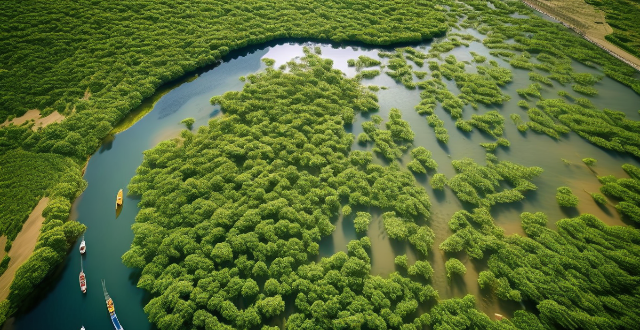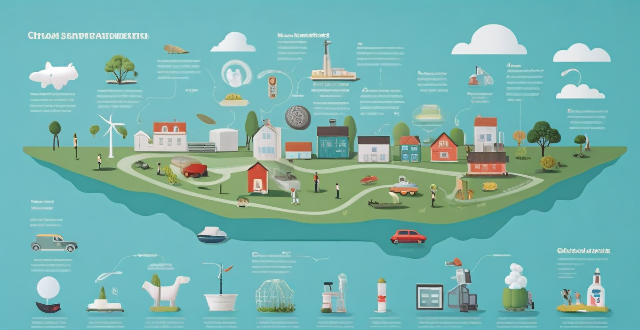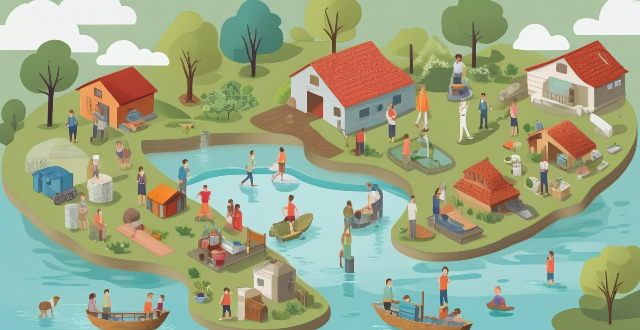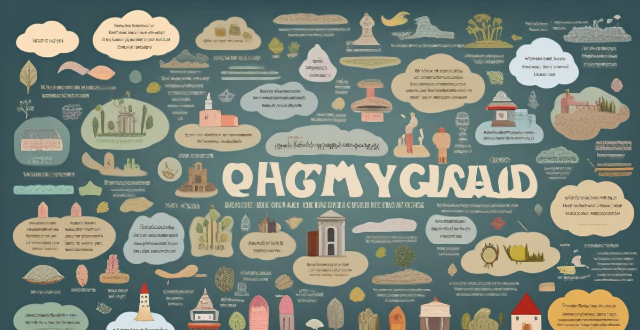Diversity Ecosystem

What is the significance of genetic diversity within biodiversity ?
Genetic diversity is a vital component of biodiversity, playing a crucial role in ecosystem health and stability. It enables species to adapt to environmental changes, resist diseases, contribute to ecosystem functioning, support food security, and provide medicinal plants. However, threats such as habitat loss, overexploitation, climate change, introduced species, and pollution pose significant risks to genetic diversity. Conservation efforts must prioritize the protection and restoration of genetic diversity to ensure the long-term survival of species and ecosystems.

How does biodiversity affect ecosystem services ?
Biodiversity plays a vital role in ecosystem services, including provisioning (like food and water), regulating (climate and flood control), cultural (recreational and spiritual enrichment), and supporting services (soil formation and nutrient cycling). Diverse plant species ensure resilience against pests and diseases, reducing the need for chemical interventions. Wetlands with varied vegetation types can more effectively filter pollutants from water than those with limited plant diversity. Different plant species play roles in carbon sequestration through photosynthesis, leading to more efficient carbon uptake and storage. Biodiversity can help regulate diseases by reducing the likelihood of pathogen spread. Diverse environments like coral reefs or tropical rainforests offer richer experiences for activities such as diving, hiking, and birdwatching. A variety of organisms, including bacteria, fungi, and earthworms, contribute to soil formation and maintenance, which is essential for plant growth. Different species have specialized roles in the cycling of nutrients. High biodiversity means functions can be performed by multiple species, providing a safety net if one species fails. Conservation efforts aimed at protecting and restoring biodiversity are vital for the sustained health of our planet's ecosystems.

What is the relationship between biodiversity and ecosystem services ?
The text discusses the relationship between biodiversity and ecosystem services, emphasizing that biodiversity is crucial for maintaining the health and functionality of ecosystems. It highlights that diverse species contribute to ecological processes, and many ecosystem services rely on specific species or groups. High biodiversity can lead to more resilient ecosystems, while its loss can diminish these services. The text suggests that conservation efforts can enhance both biodiversity and ecosystem services, underlining the importance of recognizing and protecting this relationship for human well-being.

How do climate change and ecosystem services interact ?
Climate change and ecosystem services are interconnected phenomena that impact our planet. Climate change affects ecosystem services such as water regulation, food production, air purification, and recreational opportunities. Conversely, ecosystem services play a crucial role in mitigating climate change by promoting carbon sequestration, conserving biodiversity, and supporting sustainable land use practices. To address these challenges effectively, it is essential to consider both climate change and ecosystem services holistically and work towards integrated solutions that protect our planet's natural systems while meeting human needs sustainably.

What are the impacts of climate change on tree species diversity in forests ?
Climate change significantly impacts tree species diversity in forests through altered growth and reproduction patterns, range shifts, disturbance regimes, direct physiological effects, and changes in ecosystem services. These impacts not only affect the health and structure of forests but also have broader ecological and societal implications.

How do ecosystem-based adaptation methods contribute to climate resilience ?
Ecosystem-based adaptation (EBA) methods play a crucial role in building climate resilience by leveraging the natural capacity of ecosystems to mitigate and adapt to the impacts of climate change. These approaches focus on conserving, restoring, and promoting sustainable management of ecosystems to provide essential services that help communities cope with climate-related stresses. Below are several ways EBA methods contribute to enhancing climate resilience: Protection from extreme events, enhancement of biodiversity, promotion of sustainable livelihoods, regulation of water resources, carbon sequestration and storage, community empowerment and education, disaster risk reduction, and research and innovation.

What are the impacts of global warming on ecosystems and species diversity ?
Global warming, primarily caused by human activities, significantly impacts ecosystems and species diversity. These effects include habitat loss, altered species interactions, the spread of invasive species, disease proliferation, ocean acidification, melting permafrost, changes in fire regimes, water stress, sea level rise, coral bleaching, increased extinction risk, shifting ranges, population declines, adaptation challenges, loss of genetic diversity, behavioral changes, phenological shifts, reproductive challenges, physiological stress, and disrupted mutualisms. Addressing these issues requires immediate action to reduce greenhouse gas emissions and adapt to the changing climate.

What are some strategies for conserving and managing ecosystem services ?
Ecosystem services are vital for human survival and well-being, providing food, water, flood control, cultural enrichment, and more. To conserve and manage these services effectively, strategies include protecting natural habitats, using resources sustainably, managing watersheds, adapting to climate change, promoting education and awareness, implementing supportive policies and legislation, and conducting ongoing research and monitoring. These efforts aim to safeguard ecosystems for future generations.

What is biodiversity and why is it important ?
Biodiversity is the variety of life on Earth, including ecosystems, species, and genetic variation within species. It plays a vital role in supporting ecosystem services, ensuring food security, providing medicinal resources, enriching cultural heritage, and enhancing resilience to environmental changes. The loss of biodiversity can lead to reduced ecosystem function, increased vulnerability, economic impact, and loss of future options. Protecting biodiversity involves habitat protection, sustainable use, legislative measures, public awareness, and research and monitoring. Conserving biodiversity is essential for maintaining the balance of ecosystems and ensuring that future generations can enjoy the benefits provided by the variety of life on Earth.

How can we measure the value of ecosystem services ?
The article discusses various methods to measure the value of ecosystem services, which are benefits humans derive from ecosystems. These include provisioning, regulating, cultural, and supporting services. Measuring their value is crucial for informed decisions about management and conservation. Methods include direct market valuation, indirect market valuation, revealed preference methods, avoided cost method, replacement cost method, and benefit transfer method. By using these techniques, policymakers and managers can make informed decisions about resource allocation for ecosystem conservation and restoration.

How do climate targets relate to ecosystem conservation efforts ?
The text discusses the interconnection between climate targets and ecosystem conservation efforts, emphasizing that both are essential for a sustainable future. Climate targets focus on reducing greenhouse gas emissions and adapting to climate change impacts, while ecosystem conservation aims to protect biodiversity and maintain ecological processes. The two concepts are closely related, as climate change affects ecosystems, and ecosystems play a role in climate regulation. An integrated approach combining these efforts can lead to more effective outcomes, such as reforestation projects that sequester carbon and provide habitat for wildlife. Collaboration between various stakeholders is crucial for aligning climate targets with ecosystem conservation efforts.

What role does diversity play in multicultural education ?
The text discusses the role of diversity in multicultural education, highlighting its benefits such as enhancing cultural awareness, promoting tolerance and acceptance, encouraging open-mindedness and critical thinking, and providing opportunities for personal growth and development. The author emphasizes that embracing diversity in education can contribute to creating a more inclusive and harmonious society.

What are ecosystem services and why are they important ?
Ecosystem services are benefits people obtain from ecosystems, including provisioning, regulating, cultural, and supporting services. These services play a crucial role in maintaining human health, well-being, and economic prosperity. Provisioning services provide food, water, timber, and medicinal resources necessary for human survival. Regulating services help control natural processes and mitigate disasters, protecting us from environmental hazards. Cultural services encompass non-material benefits like spiritual enrichment, recreation, and education. Supporting services enable the production of all other ecosystem services and are fundamental to the functioning of ecosystems. Preserving and enhancing these services through sustainable practices ensures a healthier planet and a brighter future for generations to come.

How can teacher training address cultural diversity in the classroom ?
In today's globalized world, cultural diversity is an increasingly important aspect of modern classrooms. Teacher training can play a crucial role in addressing this diversity by incorporating it into curriculum design, adapting teaching methods, providing professional development opportunities, and implementing fair assessment practices. By doing so, teachers can create inclusive classrooms where all students feel valued and supported, promoting equity and enhancing learning outcomes.

Can you provide examples of different types of ecosystem services ?
The text provides a detailed summary of the four main types of ecosystem services, namely supporting, regulating, provisioning, and cultural services. Supporting services form the foundation for all other services and include nutrient cycling, soil formation, and primary production. Regulating services control ecological processes such as climate regulation, disease regulation, and water purification. Provisioning services provide direct material benefits to humans, including food, freshwater, timber, and medicine. Cultural services encompass non-material benefits that contribute to human well-being, such as recreation, spiritual enrichment, and educational opportunities. The text emphasizes the importance of understanding these different types of ecosystem services to appreciate the value of nature and the significance of conservation efforts.

What is the role of ecosystem services in sustainable development goals ?
Ecosystem services, including provisioning, regulating, cultural, and supporting services, play a vital role in achieving sustainable development goals (SDGs) by providing essential resources for human well-being and economic development while maintaining the health and resilience of natural systems. Provisioning services like food security, clean water, energy, and medicinal resources are crucial for meeting SDGs 2, 6, and 7. Regulating services such as climate regulation, disease regulation, and flood and erosion control contribute to SDGs 13 and 15. Cultural services like recreation and tourism and cultural and spiritual values support SDG 8. Supporting services like soil formation and nutrient cycling and pollination are essential for agriculture and hence SDG 2. The interconnectedness of ecosystem services with other SDGs highlights their importance in building resilient societies that can withstand future challenges such as climate change, environmental degradation, and economic fluctuations. Preserving and enhancing these services is essential for achieving a sustainable future for all.

What are the main threats to global biodiversity ?
The article discusses the main threats to global biodiversity, which include habitat loss and fragmentation due to urbanization, agricultural expansion, and mining and extraction; climate change with rising temperatures, altered precipitation patterns, and extreme weather events; pollution from chemicals, noise, and light; overexploitation through overfishing, hunting and poaching, and harvesting of plants; invasive alien species competing for resources, transmitting diseases, and altering habitats; and human population growth leading to increased consumption, waste production, and conflict with wildlife. These threats are interconnected and require coordinated efforts from various stakeholders to implement sustainable practices and protect our planet's diversity of life.

How does cultural diversity affect communication within a workplace ?
Cultural diversity has a profound impact on workplace communication, presenting both challenges and benefits. Challenges include misunderstandings due to language barriers and differences in non-verbal cues, variations in communication styles, and differing norms and expectations. Benefits encompass enhanced creativity, improved problem-solving, and greater empathy. Strategies for promoting effective communication involve education and training, clear messaging, open dialogue, and celebrating diversity. By addressing challenges and leveraging benefits, organizations can build cohesive teams that thrive on their collective differences.

How do climate policies intersect with other environmental initiatives, such as biodiversity conservation ?
The text discusses the intersection of climate policies and biodiversity conservation, highlighting the importance of integrating these initiatives for a sustainable future. It emphasizes reducing greenhouse gas emissions, protecting ecosystems, promoting sustainable land use practices, encouraging collaboration, and integrating climate change into biodiversity conservation strategies as key points of intersection. The benefits of integration include enhanced ecosystem resilience, improved carbon sequestration, increased public awareness, more efficient use of resources, and greater policy coherence.

What role does media play in shaping our perception of cultural diversity ?
This article explores the significant role of media in shaping our perception of cultural diversity. It highlights how media exposure to different cultures, representation of cultural diversity, and influence on attitudes and beliefs contribute to understanding and appreciation of cultural diversity. The article encourages critical thinking and active seeking out of diverse perspectives to promote a more inclusive society.

How does social inclusion relate to diversity and multiculturalism ?
The article discusses the relationship between social inclusion, diversity, and multiculturalism. It defines each concept and explains their importance in promoting equality, participation, and belonging. The article also highlights the benefits of diversity and multiculturalism, such as enhanced creativity and understanding among different cultural groups. The intersectionality of these concepts is explored, along with examples of inclusive policies and practices. Education is emphasized as a crucial tool for promoting social inclusion, diversity, and multiculturalism. Overall, the article concludes that these interconnected concepts are essential for building a more equitable and harmonious society.

How has globalization impacted cultural diversity around the world ?
Globalization has significantly impacted cultural diversity, leadingGlobalization has significantly impacted cultural diversity, leading adaptation but also potential homogen Policy and governance play a role in cultural preservation, with local resistance movements countering globalization effects. Striking a balance between global benefits and cultural preservation is crucial for maintaining diversity.

In what ways do immigration policies affect the cultural diversity of a country ?
Immigration policies play a significant role in shaping the cultural diversity of a country. Policies that promote multiculturalism, facilitate family reunification, and provide opportunities for legal migration can enhance cultural diversity. In contrast, strict immigration controls, deportation policies, and anti-immigrant sentiments can hinder it.

How can we celebrate cultural diversity through festivals and events ?
Celebrating cultural diversity is a beautiful way to foster understanding, respect, and appreciation for different cultures. Festivals and events are perfect platforms for this celebration as they bring people together in a festive atmosphere that encourages sharing and learning about diverse traditions. Here's how we can celebrate cultural diversity through festivals and events: Inclusivity in Planning and Participation: To ensure that cultural diversity is celebrated genuinely, it's essential to involve members from various cultural backgrounds in the planning and execution of festivals and events. This approach ensures that traditions are represented authentically and respectfully. Showcasing Cultural Arts and Performances: Artistic expressions like music, dance, theater, and visual arts are integral to many cultures. Featuring these during festivals allows attendees to experience the depth and beauty of different cultural art forms. Food Festivals and Culinary Experiences: Food is a universal language that transcends borders. Organizing food festivals or culinary workshops that highlight dishes from various cultures can be a delightful way to celebrate diversity. Educational Workshops and Discussion Panels: Providing opportunities for learning and dialogue enhances the understanding of different cultures. Workshops and panel discussions can cover topics like history, traditions, and contemporary issues affecting various cultural groups. Community Interaction and Networking: Festivals and events should encourage interaction among participants to build connections and foster a sense of community. These interactions can lead to lasting friendships and mutual respect among diverse groups. Respectful Representation: When celebrating cultural diversity, it's crucial to ensure that representations are respectful and avoid stereotyping or caricatures. Research and collaborate with cultural representatives to ensure accuracy and sensitivity in all aspects of the event.

What is the connection between educational psychology and cultural diversity in the classroom ?
The text discusses the importance of integrating educational psychology and cultural diversity in classroom settings to enhance learning experiences, social skills, and academic achievement. It highlights the benefits of cultural diversity in education, including enhanced learning experiences, improved social skills, and increased academic success. The role of educational psychology is also emphasized, as it provides insights into how cultural diversity affects student learning and development. Key concepts related to cultural diversity in educational psychology include cognitive development, motivation, social interaction, and assessment. Strategies for integrating cultural diversity into educational psychology practices are also discussed, such as culturally responsive teaching, inclusive curriculum design, collaborative learning, and professional development opportunities. Overall, the text underscores the significance of addressing cultural diversity in the classroom through educational psychology principles and practices.

How do I evaluate the cultural diversity and inclusion efforts of a school ?
Evaluating the cultural diversity and inclusion efforts of a school involves examining various aspects such as administrative policies, curriculum, student experience, community engagement, and feedback mechanisms. Key factors to consider include the presence of a clear diversity statement in policies, fair hiring and promotion practices, multicultural curriculum, teacher training, diverse student organizations, support services for diverse students, collaboration with local communities, family involvement programs, regular surveys and feedback mechanisms, and continuous improvement plans based on feedback. By assessing these elements, one can gain insight into the effectiveness of a school's efforts to promote cultural diversity and inclusion.

What is the impact of climate action on biodiversity and ecosystems ?
Climate action has both positive and negative impacts on biodiversity and ecosystems. Positive effects include reduction in greenhouse gas emissions, increased awareness and education, protection of key habitats, promotion of sustainable practices, and restoration of degraded ecosystems. Negative effects include displacement of local communities, habitat loss and fragmentation, ecosystem disruption, resource competition, and uncertain long-term outcomes. To maximize the benefits of climate action for biodiversity and ecosystems, an integrated approach that considers both environmental and social factors is crucial.

How can the media be used to combat negative stereotypes and promote diversity within sports ?
The article discusses how media can be used as a tool to combat negative stereotypes and promote diversity in sports. It highlights the impact of stereotypes on sports, both positive and negative, and suggests ways for media outlets to challenge these stereotypes by showcasing diverse athletes, addressing bias and discrimination, and encouraging open dialogue about diversity. The article also provides examples of successful diversity promotion in sports media, such as increased coverage of women's sports and disability sports, and efforts to promote racial diversity within sports coverage.

How do these education policy updates address issues related to diversity and inclusion ?
Education policy updates are crucial for addressing diversity and inclusion in schools. They aim to create an equitable learning environment that caters to the needs of all students, regardless of their background or identity. These updates contribute to promoting diversity and inclusion by recognizing and valuing diverse perspectives, providing access to education for all students, promoting cultural competency among educators, encouraging inclusive curriculum design, addressing bias and stereotyping, and supporting special education needs. By implementing these policies, schools can create a more equitable and inclusive learning environment that benefits all students, regardless of their background or identity.